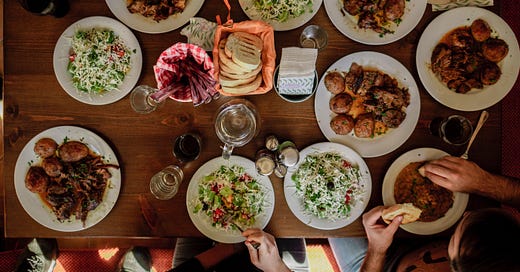Photo by Stefan Vladimirov on Unsplash
Most of my students are people watchers anyway, so this assignment isn’t much of a stretch: what if you observed the family dynamics in a typical holiday meal in order to write a scene with multiple characters?
I asked my class: does your family observe a typical Thanksgiving dinner? Most of them would be traveling to a relative’s house to eat turkey and sides. One student was going to work with her parents at a local shelter serving Thanksgiving dinner to the homeless. Another student was going to be traveling to India to visit her great-aunt who was in ill health.
All of them were doing something that would allow them to observe a group of people who may or may not spend much time together normally, navigating a meal where people were expected to play nice for at least for a couple of hours.
A writer’s dream.
To that end, I asked them to do some field research during their Thanksgiving meal on family dynamics for writing a scene that includes at least six people. After reading Joe Fassler’s interview with Alexander Chee on How To Write a Party Scene, the class breaks into two groups: one group reading Fitzgerald’s scene, one group reading Letts’s scene.
Fitzgerald’s Scene
While Jay Gatsby’s parties in F. Scott Fitzgerald’s The Great Gatsby are a delight to deconstruct, I like to use the smaller party scene when Nick accompanies Tom and his married girlfriend, Myrtle Wilson, to their New York apartment. They ring up her sister, Catherine, and Mr. and Mrs. McKee, the downstairs artist and his wife. Oozing with booze, gossip, artifice, infidelity, and delusion, this tableau is a perfect party scene for students to deconstruct. Starting with a discussion of photography and ending with a broken nose, this scene moves mainly on dialogue with a few brush stroked anchor paragraphs for mood and setting.
After reading the scene, discuss and analyze how the scene is built.
Discuss and list five craft moves that Fitzgerald uses.
Discuss and list the narrative effect of each of these moves.
Letts’s Scene
August Osage County, Tracy Letts’s award-winning stage and screenplay about familial abuse, is another source for multiple-person scene Three daughters come home to bury their father. A meal in the dining room serves as the setting for weaving all the personalities at the table into one seamless riff on family dysfunction, beginning with passing the casserole and ending with a daughter tackling her mother to wrestle a pill bottle out of her hand. The scene (running from page 71-89) is a master class in writing a scene of family dysfunction where the matriarch eviscerates everyone for her own miserable life, justifying her screed by claiming to be a “truth teller.”
After reading the scene, discuss and analyze how the scene is built.
Discuss and list five craft moves that Letts uses.
Discuss and list the narrative effect of each of these moves.
To gather their own field research during Thanksgiving, here are some questions to start students observing human behavior and gathering their own information about writing scenes with multiple characters:
Who is in attendance?
Who sits where and with whom?
Is there a mood in the house where you are gathering?
What different conversations do you overhear?
Are there a variety of distractions (televisions blaring, little kids playing ball in the house, music cranked up) and how do they impact the gathering?
Is there one personality that overshadows all the rest? One voice louder than the rest?
Are people consciously or unconsciously allying themselves with one another?
Are there satellite meeting places in the gathering - outside, basement, front porch? Who escapes to those spots?
What archetypal “role” does each person play in the family outside of their roles as “sister” or “mother”?




